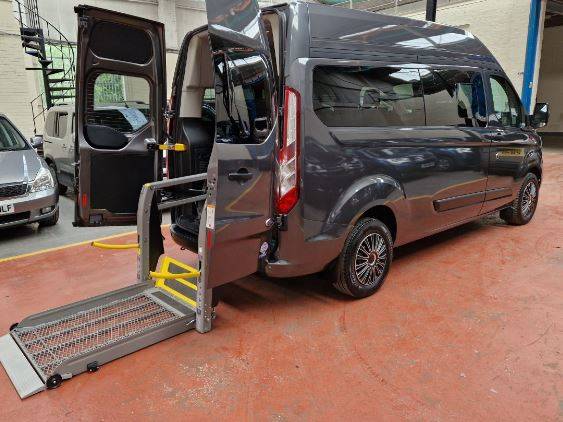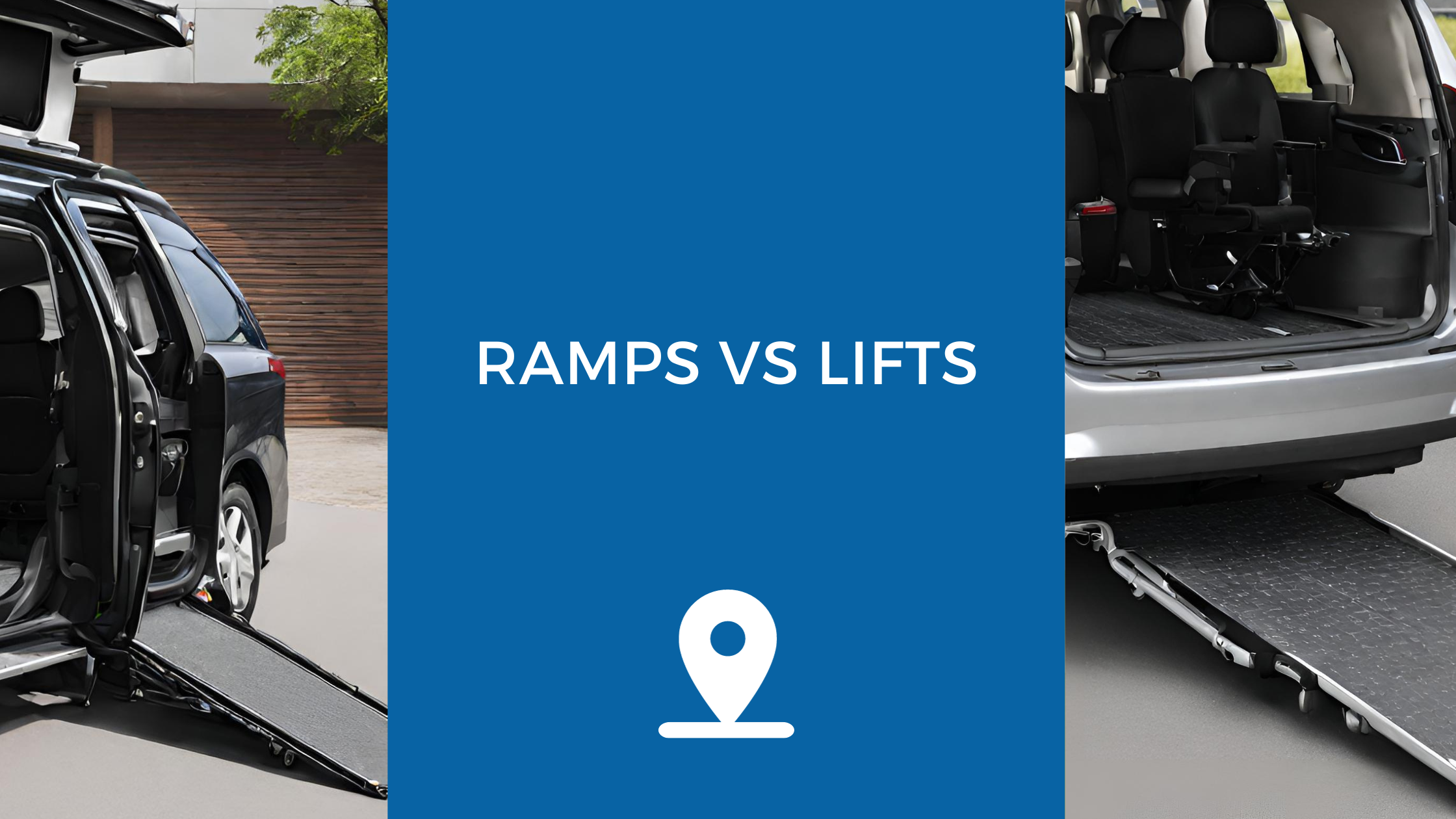Wheelchair Ramps vs Lifts
Ensuring that everyone has the opportunity to travel independently and with dignity is a fundamental aspect of our society. When it comes to making vehicles accessible for people with mobility challenges, two primary options are commonly considered: wheelchair ramps and powered lifts.
Each option has its own set of advantages and drawbacks and the choice between them depends on various factors.
Understanding Accessibility in Vehicles
Wheelchair accessible vehicles are designed to ensure that individuals with disabilities can travel without barriers and with dignity. When vehicles are designed with accessibility in mind, they empower individuals to move independently, participate in everyday activities and lead fulfilling lives.
Wheelchair Ramps
What is a Wheelchair Ramp?
A wheelchair ramp is a sloped surface that allows individuals using wheelchairs to enter and exit a vehicle with ease, usually from the rear of the vehicle, but side entry ramps are available. It's a simple yet effective solution designed to bridge the gap between the ground and the vehicle's interior, ensuring a smooth transition for the user.
Advantages of Wheelchair Ramps
Ease of Use
One of the primary advantages of wheelchair ramps is their ease of use. Ramps are simple to operate, making it accessible for individuals with limited mobility to board a vehicle. There's no need for complex machinery or a learning curve, which is especially important for independent travel.
After the ramp has been used, it can be safely folded away at the rear of the vehicle until the end of the journey when it will be required again.
Cost-Effectiveness
Cost is a significant consideration for many individuals and organisations. Wheelchair ramps are often more affordable than lifts, making them a popular choice. The affordability of ramps allows for a broader range of vehicles to be modified for accessibility.
Limitations of Wheelchair Ramps
Space Requirements
While wheelchair ramps are relatively straightforward, they do require a certain amount of space for installation. This can be a limitation in smaller vehicles where space is at a premium which is why we convert specific vehicles, namely compact to large vans, that can accommodate a ramp.
Inclined Angle
The angle of the ramp is crucial for safety and ease of use. Ramps with steep inclines can be challenging for some users to navigate, and they may not comply with accessibility standards. Therefore, finding the right balance between the required length and slope of the ramp is important.
Vehicle Lifts

What is a Vehicle Lift?
A powered vehicle lift is a mechanical device that raises and lowers a wheelchair and its occupant into and out of the vehicle. It's a more complex solution than a ramp, involving a system of motors, hydraulics and controls to smoothly and securely transport the user and their mobility device.
Advantages of Vehicle Lifts
Ease of Use
One of the significant advantages of vehicle lifts is the ease of use. As it is a powered lift, no physical intervention is needed, making it ideal for those who have difficulty pushing a wheelchair up a ramp and into the vehicle.
Smooth Entry
Vehicle lifts offer a smooth and controlled entry and exit for wheelchair users. The design ensures that the user is securely lifted or lowered into the vehicle, reducing the risk of accidents or discomfort during the process.
Limitations of Vehicle Lifts
Cost
While vehicle lifts offer many benefits, their complexity comes at a price. Vehicle lifts are generally more expensive than ramps, which can be a deterrent for individuals who want a lower cost wheelchair accessible vehicle.
Maintenance and Repairs
Like any mechanical system, vehicle lifts require maintenance to ensure they function correctly and safely. Maintenance can be an ongoing cost, and if the lift experiences issues, repairs can be expensive. It's crucial to factor in these long-term costs when considering a lift.
Choosing the Right Option
The decision to choose a wheelchair accessible vehicle with a wheelchair ramp or a vehicle lift is significant and should be made after careful consideration. Several factors play a role in making this choice:
Assessing Individual Needs
The first step in the decision-making process is to assess the specific needs of the individual who will be using the accessible vehicle. Consider their mobility, any additional equipment or devices, and their level of independence in transferring to and from a wheelchair.
It's crucial to evaluate the mobility challenges of the individual. For those with greater mobility and independence, a wheelchair ramp may be a suitable choice. Ramps are well-suited for individuals who can confidently manoeuvre their wheelchairs and transfer to and from their seats with minimal assistance. In such cases, the simplicity and ease of use of ramps can provide a practical and cost-effective solution.
Conversely, individuals with more complex mobility challenges or those who rely on powered wheelchairs may find vehicle lifts to be a better fit. Lifts provide a secure and controlled mechanism for transferring both the user and their wheelchair into the vehicle, which can be essential for individuals with limited upper body strength or coordination.
Vehicle Type
The type of vehicle you intend to make accessible is another crucial consideration. Vans, buses, and private cars may have different requirements and space limitations. Larger vehicles like people carriers may have more room for ramps, making them an ideal choice for public transportation and larger groups of passengers. In contrast, compact vehicles like cars and smaller vans may not have sufficient space for a ramp, making lifts a more suitable option.
The layout of the vehicle is also a key factor. Some vehicles may have side-entry points, while others may have rear-entry options. The choice between a ramp and a lift may depend on the available entry points in the vehicle and the space available for installation.
Budget Considerations
Budget constraints can play a significant role in the decision-making process. Determine how much you are willing to invest in making your vehicle accessible. While ramps are generally more budget-friendly, it's essential to consider the long-term costs of maintenance and repairs for both ramps and lifts.
Consider both the initial investment and the ongoing costs associated with your choice. Ramps are often more cost-effective initially, but they may require modifications to the vehicle's structure and maintenance over time. Lifts, on the other hand, may have a higher upfront cost but can be more space-efficient and require less structural alteration of the vehicle.
Maintenance and Repairs
Maintenance and repair considerations are particularly vital if you're making this decision for an organization or a fleet of vehicles. Factor in the ongoing maintenance and repair costs when making your choice. Wheelchair ramps typically require less maintenance, as they have fewer mechanical components. They may need occasional cleaning and inspection to ensure they remain in good condition.
Vehicle lifts, being more complex, may require regular maintenance to keep all components in working order. The hydraulic systems, electrical controls, and mechanical parts need attention to ensure safety and reliability. Regular servicing and inspections by qualified technicians are essential to maintain the lift's performance.
Conclusion
When choosing between a wheelchair ramp and a vehicle lift for a used WAV, it's important to weigh the individual needs of the user, the type of vehicle, budget considerations, and long-term maintenance requirements. Making an informed choice ensures that individuals with mobility challenges can travel with independence and dignity, irrespective of their chosen accessibility solution.
Choosing between wheelchair ramps and lifts for your vehicle is an important decision that depends on various factors such as cost, ease of use, and personal preferences. While ramps are generally more affordable and require less maintenance, lifts can be more convenient for some users, especially those with limited upper body strength.
When considering mobility solutions, it's crucial to explore all options and read reviews from other users. For comprehensive assessments of various mobility aids and vehicles, you may find valuable insights at Review Mobility, a platform dedicated to helping individuals make informed decisions about their mobility needs.


